

Kentucky Bourbon Trail (21 August 2011)
click here for the photo gallery
Kentucky bourbon distilleries tour, 20 August 2011
Travelling to the South-West of Indiana, I took the opportunity a day of to visit some of the bourbon distilleries in the state of Kentucky. After an almost 200 miles (300+ km) drive, I arrived on Friday evening in Frankfort, the capital of KY, since I intended to start my small tour with the Buffalo trace distillery. Since my time was very limited, I changed my plan over night and decided to start with Four Roses before moving to Wild Turkey, Woodford reserve, Buffalo Trace and a visit at the Bourbon Heritage Center at the Heaven Hill distilleries.
Foreword:
Since the definition of bourbon might not be known by the reader, please find below the legal definition for a whiskey to be called bourbon (27 Code of Federal Regulation 5:
Only whiskey produced in the United States can be called bourbon.
Bourbon must be made from a grain mixture that is at least 51% corn.
Bourbon must be aged in new, charred oak barrels.
Bourbon must be distilled to no more than 160 (U.S.) proof (80% alcohol by volume).
Bourbon must be entered into the barrel for aging at no more than 125 proof (62.5% alcohol by volume).
Bourbon, like other whiskeys, must be bottled at 80 proof or more (40% alcohol by volume.)
Bourbon has no minimum specified duration for its aging period, although it must be aged at least briefly. However, the following definitions and requirements apply that relate to aging periods:
Bourbon that meets the above requirements, has been aged for a minimum of two years, and has no added coloring, flavoring, or other spirits may (but is not required to) be called Straight bourbon.
Bourbon that is labeled as Straight that has been aged for a period less than four years must be labeled with the duration of its aging.
Bourbon that has an age stated on its label must be labeled with the age of the youngest whiskey in the bottle (not counting the age of any added neutral grain spirits in a Bourbon that is labeled as Blended, as neutral grain spirits are not considered whiskey under the regulations and are not required to be aged at all).
Bourbon that is labeled as Blended (or as ‘a blend’) may contain added coloring, flavoring, and other spirits (such as un-aged neutral grain spirits); however, at least 51% of such a product must be Straight Bourbon.
Bourbon can be produced anywhere in the USA, but 95% of the bourbon production is made in the state of Kentucky. A whiskey stored for 1 year and 1 day in Kentucky can be called Kentucky Straight.
The Kentuky Bourbon Trail tour (or at least, part of it and some extra).
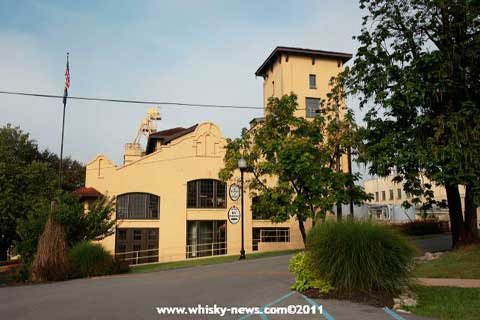 |
| The Four Roses Distillery |
| A video tour of Four Roses |
After a 30 min drive, I arrived at 8.57 am at the Four Roses, on time for the distillery tour that started at 9.00 sharp. Four roses distillery was not in production during my visit, as well as for all the other distilleries I visited. The reason was due to the temperature (about 30-32°C), too high for the yeast to ferment efficiently the wash. The Four Roses distillery is a meidum-sized distillery owned by the Japanese company Kirin, with all building painted in a yellow colour similar to the label. The design of the main distillery was inspired from a Hacienda (Spanish Mission-Style architecture). The distillery is very compact and uses Cyprus red washbacks for its fermentation. The distillery produces two types of mashes (mash bills): OF (corn (maize) 75%, rye 20%, malted barley 5%) and OB (corn 60%, rye 35%, malted barley 5%) and uses 5 types of yeasts (V: light fruit, K: slight spice, O: robust fruit, F: herbal, Q: floral).
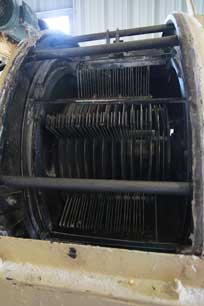 |
| The inside of a grain mill |
By combining the two types of mashes and the 5 type of yeast, Four roses produces 10 different recipes that are then combined (mingled) to produce the final product. The fermentation time is 72h. The resulting beer (wash) is then run through a copper column still where it is distilled allowing to concentrate the alcohol at approximately 132 proof (66% alcohol by volume, abv) before it is sent to a "doubler" (pot still) that increases the alcohol content to approximately 140 proof (70%). The spirit ("white dog") is reduced to 120 proof (60%) with de-mineralized water. It is then filled in a cask and stored in warehouse situated 1h drive from the distillery.
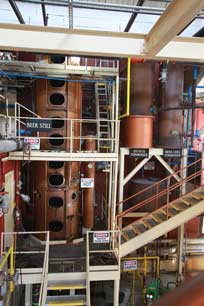 |
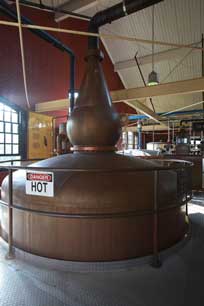 |
| The beer still | and the doubler (pot still) |
At the end of the tour, I had the opportunity of tasting the Four Roses original, which was significantly better than the version bottled 20 years (see tasting), as well as the Four Roses small batch bottled at a higher strength as well as one single cask expression. A very enjoyable tour in a beautiful area and free of charge. Surprisingly, under its previous owner (Pernod Ricard), Four Roses was an export only product and was released on the US market first in 2003. This was followed 1 year later by the launch of their Single Barrel and in 2006, by the Four Roses Small batch. Four roses is the only distillery in the USA to use single storey rack warehouses.
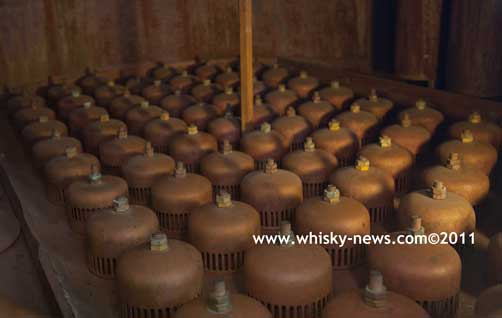 |
| Details of the beer (continous) still at Four Roses |
As soon as the tasting was over, I moved quickly to my car for a short drive to Wild Turkey distillery where I registered to join the tour of 10. 30 free of charge. The distillery center was of similar size as Four Roses, but more crowded and located a few hundred meters far from the new distillery. At 10.30, we took a bus for a drive to the new Wild Turkey distillery inaugurated in December 2010. Wild Turkey whiskey is matured for 8 years before being bottled.
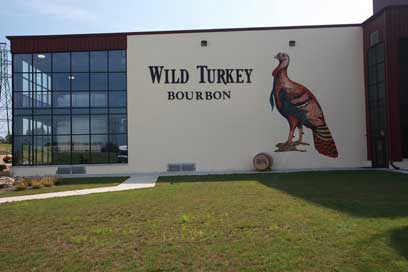 |
| The new Wild Turkey distillery |
After a 10 min movie, we moved rather quickly through the distillery. The building is very modern and several yeast tanks could be seen through from the windows. With the main focus being taking photographs of the distillery, I unfortunately missed capturing the technical details. While there was a handful of washbacks (fermenters) at Four Roses, the main section of the Wild Turkey distillery contained a very large amount (30?) of stainless steel wash backs of 30,000 gallons, dwarfing any Scotch malt distillery, as well as a beer vat of 42,000 gallons. The distillation takes place in one single continuous still and the white dog is filled in char 4 (Alligator) American white oak casks. The distillery is filling 0.5 mio barrel a year and they plan to increase their production close to their maximal capacity of 1 mio barrel a year. Campari, the owner of Wild Turkey is planning to increase the sales of Wild Turkey. The main markets are Australia followed by Japan.
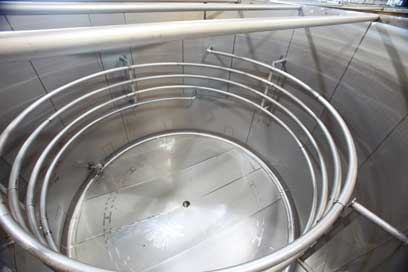 |
| The inside of a 30,000 gallons fermenter (washback) |
After the distillery itself, the bus took us to one of the warehouse present on the premises. The warehouse is similar to the palletized warehouses that you can find in Scotland, built racked over several stories high in warehouses with an impressive timber framework.
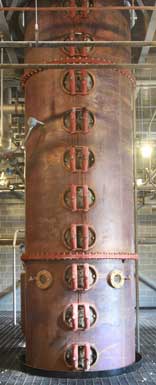 |
| The still at Wild Turkey |
Afterwards, we completed the tour with the tasting. The whole range was available and you could choose any of the two. I decided to taste the rich and spicy Russell's Reserve 6 YO Rye and a single barrel expression, the Kentucky Spirit. Amongst the lineup was the new Wild Turkey 81 Proof that replaces the 80 Proof version. The 81 Proof is the same whisky as the 101 Proof but reduced to a lower proof by adjunction of demineralized water. A new visitor center will be built next year, given view over the river and the old iron bridge.
 |
| A rick house (warehouse) at Wild Turkey distillery. |
On the road to my next destination, Woodford Reserve, I could observe some magnificent farms with well kept fences and well groomed racing horses. Woodford Reserve is located in a very nice looking and lush green area. Well worth a visit. The visitor center of Woodford reserve has been recently built and offers a surface probably as a large at the distillery itself. According to the Bourbon Trail leaflet, the tour leaves on the hour. Since it was so full, I had to wait until 12.30 before the tour started, giving me the time to enjoy a homemade sausage and lentil's soup.
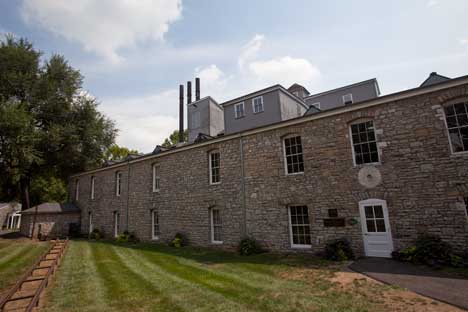 |
| Woodford reserve distillery |
Cyprus fur washbacks are used at the distillery in a lovely stone building. The resulting product is then triple distilled using traditional pot stills manufactured by Forsyth in Rothes (Scotland). The production at the distillery is very small: 150 barrels are filled in a week, while 2250 barrels are filled in 1 day at the Jack Daniel's distillery in Tennessee. All the operations are made in the distillery, from production to bottling. The Woodford reserve is a 6-8 years old whiskey and the warehouse is rather unique, since it has features both a cooling and heating system to reduce temperature changes over the year.
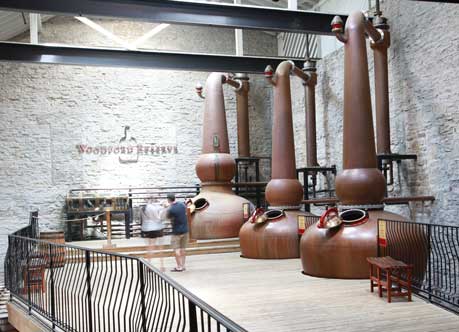 |
| Woodford Still house |
With the $5 of the tour was included a small measure of Woodford reserve (about 1 cl pour) and a small plastic shot glass. The size of the operation and the flow of visitors reminded me of the Edradour distillery. Touring is probably one important income source for this lovely small distillery. I broke my sample during my flight back home, but my impressions were of a very smooth, round whisky, rather rich with a nice mouth structure reminding me of a slightly heavier variant of Irish whisky, with more treacle. Very pleasant.
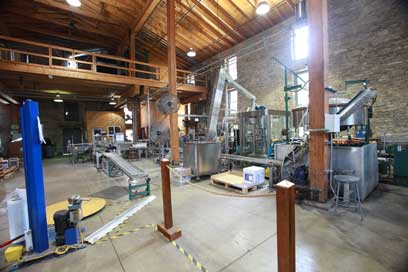 |
| Woodford bottling hall |
I arrived at the Buffalo Trace distillery at 2.03 p.m. and luckily, I managed to join the last tour of the day (2 p. m.). I planned initially to attend to the Hard Hat tour where you can visit the distillery itself, but due to the barrel rolling competition taking place on that day, I had to content myself with the regular free tour. Our guide has been working for over 20 years in the distillery and thus was more competent to answer most of the question. This was a contrast with the previous tours, were the guides were generally "professional guides" and not staff guiding visitors, if you see what I mean.
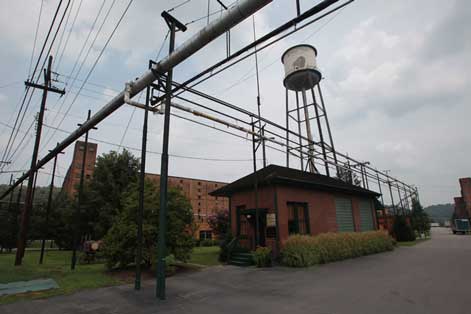 |
| Buffalo Trace with an old red brick rick house on the back. |
After a video in Warehouse D, we move further in the warehouse to view the different casks stored in there. Buffalo Trace is one of these distilleries conducting experimentation on casks, and in this case, we could see a selection of different cask sizes. Buffalo Trace has five recipes: 2 rye bourbons, 1 barley, 1 rye and 1 wheat bourbon (Weller and Pappy Van Winkle). Distillation is done in a column (continuous still) followed by a second distillation in the doubler. A copper pot still (“schnapps”) is used for experimental purposes and a rectifying column for the production of vodka (RAIN). By warehousing the bourbons in different locations and aging for different years according to that brand's taste profile, 13 different bourbons/whiskeys can be produced (see http://www.greatbourbon.com/ for the product range; thanks to Amy Preske for the technical details). During our stay in the warehouse, I was suprised to learn that the process regarding duty is very different from UK. In UK, whisky is stored duty free and the duty is only paid once the whisky is taken out of bond and being bottled. Therefore, no duty is paid on the angel share (evaporation). In the USA, duty is paid first at the time of filling and thereafter, several time. Please feel free to contact me if you have more information about the process.
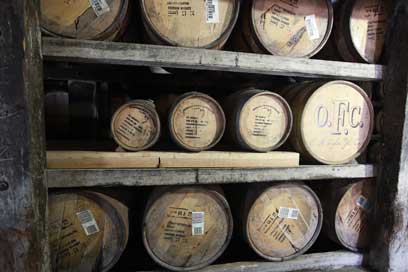 |
| Different type of casks in warehouse (rick house) D. |
We moved afterwards to the Blanton bottling hall, were the special batches of Blanton are being bottled, as well as the single cask or small batches products. Last week, the Antique Collection Autumn has just been bottled and activities for the E.H. Taylor Batch 1 have just been initiated. This small batch whiskey, bottled at 100 Proof should hit the shelves for the end of the year. The bottling hall looks very old fashion, as well as all the other red brick buildings. The Blanton’s bottling hall reminded very much of the Gordon & MacPhail bottling hall at Elgin. The visit ended up in the visitor centre where we had the option of tasting 2 whiskies amongst the whiskies proposed. My first choice was for the white dog (new make) mash n°1: an extremely smooth and grainy spirit, with the flavour intensity of a scotch grain whisky, while being smoother and less spirity. The second choice was for the very smooth and easy to dring Eagle Rare 10 YO 90 Proof.
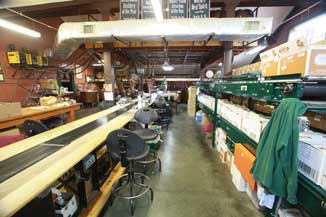 |
| The Blanton's bottling hall. |
Of note, Buffalo Trace distillery is NOT part of the bourbon trail, but definitely worth a visit. I have not seen the whole distillery, but there is definitely a feeling of traditions here and the products offer an excellent quality price value.
The last part of my whiskey tour was at the Bourbon Heritage Center in Bardstown. The Bourbon heritage centre is the visitor center of the Heaven Hill distilleries. I was too late for the last tour, but I took the opportunity of visiting this interesting visitor centre, with many old photographs capturing the life of the key figures of the Heaven Hill brands (e.g., Elijah Craig & Evan Williams).
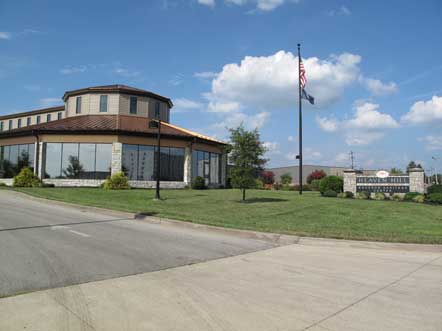 |
| The Heaven Hill distilleries Bourbon Heritage center |
On this, my visit of the Kentucky distilleries was now over. I did not complete the bourbon trail (which includes Marker’s Mark and Jim Beam), but I enjoyed my express tour very much. It offers a nice contrast to the Scotch Malt distilleries in terms of flavour profiles and production processes. For single malts, only malted barley can be used and only 1 type (or combination) of yeast is used. Barley can be peated or not, shape of the stills and temperature of the cuts will provide an unique flavour profile and by selecting different type of casks (bourbon, sherry, other wine, first fill or refill casks of different sizes) can induce changes (variations) in the final product. On the other hand, for bourbon, different flavours are generating by varying the composition of the raw ingredients (rye, corn, barley, wheat, etc) and by using different yeast types but the spirit will be always matured in virgin oak barrels (barrels, with a few exceptions). One of the major difference between the two countries is the temperature: the weather is mild in Scotland while the temperature differences between summer and winter are very high in Kentucky, therefore the warehouses (rick houses) are warmed during the Kentucky winter and the evaporation rate (4%) is significantly higher than in Scotland (2%).
If you are not too far from the Kentucky, do not hesitate to visit any of the distilleries.
Note: A few videos were recroded during different distillery tours. Please click on the item for the video
| Woodford reserve (mash) | Wild Turkey warehouses |
| Woodford bottling hall | Woodford still house |
Slainte,
Patrick
www.whisky-news.com ©27 Aug 2011